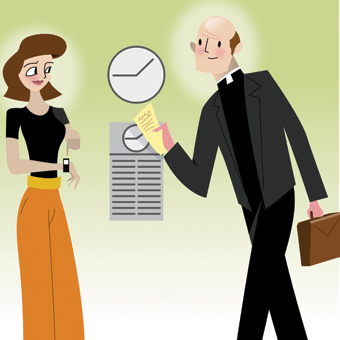The priest shortage is generating some creative solutions to parish staffing, but they require a little flexibility and a healthy sense of humor on the part of everyone involved.
When I was just a priestling growing up in seminary, I figured that if I were good and didn't get my name in the papers too much, one day I'd be a pastor in a parish with, oh, let's say two priests. Turns out that by the time I got enough credentials to qualify for the job, I ended up being the only priest in a parish with two churches! It was the same for the next assignment, too, and the next. Just as I was settling down to my present part-time job in a one-church parish, the bishop went and merged it with the one next door, and now I'm back to two churches again. What's going on?
Well, in case you haven't noticed, we've got way fewer priests now than when I signed up for the job back in '79. It seems like if the guys aren't dying or retiring, they're throwing in the towel or getting thrown out the door for God knows what. The number of priests available to staff parishes is dropping like gas prices in an election year. Bishops are tearing out their lappets trying to come up with ways to keep the lights on in the rectory.
One of the strategies getting a little play around dioceses lately is to invoke church law, specifically canon 517.2. It starts offby saying that "if, because of a lack of priests, the diocesan bishop has decided that participation in the exercise of the pastoral care of a parish is to be entrusted to a deacon or to another person who is not a priest. . ." and then goes on to explain how the process is implemented. It's come to be known as the "517.2 model" of parish staffing. So now, when you go knocking on the rectory door, there's a slim chance that the person who answers will be wearing Liz Claiborne instead of clerical tailor R.J. Toomey, smell more like Mary Kay than Ethiopian myrrh, and be carrying a baby instead of a breviary.
The number of these "other persons" running parishes is multiplying like dandelions on a spring lawn. No sooner does Father retire to Florida with his golf clubs than Mom takes the helm at the church office. Right now there are around 700 parishes of approximately 19,000 in the United States with "not-a-priest" leaders.
But no one's quite figured out what to call them. They're known by names like "parish life director" and "pastoral coordinator." In the bishops' 2005 document Co-Workers in the Vineyard of the Lord, they're called "lay ecclesial ministers." One parishioner where I work keeps referring to Lynn, our pastoral coordinator, as "the girl in the office"-though, well into middle age, she hardly qualifies as a "girl."
The first job of the pastoral coordinator is to dig up a priest to do the weekends. That's where guys like me come in. There's a whole population of priests out there who work in hospitals, prisons, or hold other administrative positions. I'm a writer. And I know you're going to find this hard to believe, but, as the bishops like to point out, some priests just don't have what it takes to be a pastor. Imagine that!
And a few-very few-are busy with their families. There are a small number of married former Episcopal priests who are now Catholic priests. So you might tell the person answering the phone that you want to talk to Father and you'll hear, "Daddy! It's for you!"
It takes a special set of skills and the right attitude to function in tandem with what in many cases will be a lay woman. But that doesn't keep a few guys from sweating the possibilities. Last year I gave a series of talks to the priests of a neighboring diocese outlining how the 517.2 model functions and told a few stories about working for my pastoral coordinator, Lynn. At the break one participant sidled up to me and, looking about conspiratorially, whispered from the side of his mouth, "Does she boss you around?" (I think this guy had been watching too many reruns of The Honeymooners.) I leaned close to him and whispered, "All the time." He was horrified.
There are some priests- but not too many-who genuinely fear that their worst nightmare is coming true: The women are taking over! Which isn't so bad. Women-lay and religious-married men, and deacons bring a wholenew set of skills and perspectives to parish leadership. We Catholics really haven't heard much from the other half of the human race. Nor have we given them much say about what goes on. And I honestly believe that one of the real problems facing the priesthood is that there is a total vacuum on the other side of the relational equation. In other words, when the priest gets home at night, no one is there to tell him what an idiot he's been that day.
I remember the first time a pastoral coordinator called me to task about a homily I preached. It was at a bicultural service and I was on a roll-I had them falling out of their pews. They were getting some of my best churchy gags, like "I love your outfit but your purse is on fire!" and "That was no lady, that was my bishop!" Just call me Father Henny.
Anyway, I was summoned to the office the next day to be reprimanded by the pastoral coordinator. It turns out that, in the manner of my comportment, I had failed to gauge the cultural sensitivities of the assembly. My savoir faire was a little too savoir and not enough faire. And she was absolutely right, no argument. Come to think of it, some of those folks falling out of their pew were actually getting up and leaving. But that was the first time I'd been called on the carpet since I was a curate 20 years ago-that is if you don't count that regrettable "fish in the miter" incident, which we won't go into.
The folks are really warming up to having a pastoral coordinator. When the new leadership was announced in our parish, one parishioner was dead set against the idea of a woman running the show. A year later she was loving it and now sings the praises of the new pastoral setup to anyone who will listen.
The 517.2 model does take some getting used to. Since the folks see me every Sunday presiding at Mass, they naturally assume that I'm in charge. So inquiries about signing up kids for First Communion, getting babies baptized, and the lack of toilet paper in the restrooms have to be gently redirected. I have developed a response that begins, "I'm only the priest."
That's not to say that the priest doesn't have an important role to play in this arrangement, but the tasks are clearly defined. I take care of Confessions, the weekend liturgies, and some funerals, and a retired priest living nearby handles the weekday Masses and whatever else might come up during the week. The rest is in the capable hands of the pastoral coordinator.
That's why we've found it necessary to incorporate Lynn into the Sunday liturgy in ways that make her visible to the people. Parishioners need to see their pastoral leader up front. For instance, she takes a principal role dividing the consecrated bread and wine into the vessels for distribution. Of course I ask her to wear pink polka dots or something to distinguish her from the priest and the deacon. You never know what people might think when a woman approaches the altar halfway through Mass.
Lynn, who wouldn't be caught dead in pink polka dots, also walks with me down the aisle at the end of Mass, which prompted one young parishioner to ask his mother, "Is that Mrs. Father Paul?"
One bishop, we'll call him Agathodorus, in an effort to get people on board with the concept, kept referring to Lynn as "the pastor" when he visited our parish for Confirmation. So the guy who wrote the general intercessions for Sunday Mass started doing the same thing in the prayers. But the deacon, who reads the prayers and who had been around since the whale coughed up Jonah, had trouble saying that. So when he got to the prayer about "Benedict our Pope, Agathodorus our bishop, and Lynn our pastor," the word pastor came out like Daffy Duck's famous line in The Scarlet puh-puh-puh-Pumpernickel.
The learning curve is steep, but these not-a-priests are pretty sharp, like with the $10-lightbulb scam. That's the one where the salesman calls and says, "Father, we're having a two-for-one sale on light bulbs at half price with an additional 20 percent off if you order two cases now at our low, low introductory price." The first time I heard that I thought, "Wow! What a deal!" And ordered four cases. But not Lynn. She asked questions like, "How much does that come to per case?" and "How many light bulbs are there in a case?" Even after I found out that I was paying $10 apiece for light bulbs, I still ordered four more cases the next time he called. Well, it sounded like a good deal.
By and large, the 517.2 model of parish leadership works. Lay ecclesial ministers have about the same performance curve as priests: Most are competent leaders, some are very good, and a few are not so hot. Their presence in the community inspires others to the vocation of lay ministry. And it gives priests like me an opportunity to exercise our ministry free from the burdens of parish management. As any parish priest quickly learns, 90 percent of what takes up his time and energy has nothing to do with the fact that he's a priest. As one cardinal pointed out recently, even if our seminaries were overflowing with candidates tomorrow, it would still be necessary to develop this most important ministry.
And just for the record: She doesn't boss me around.
This article appeared in the October 2007 issue of U.S. Catholic (Vol. 72, No. 10, pages 34-36)













Add comment